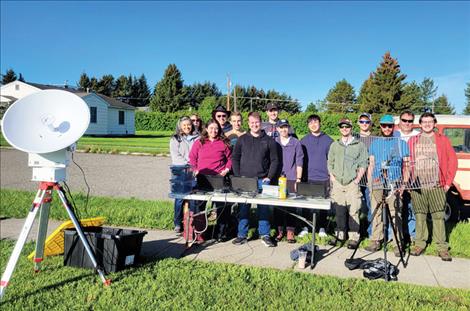Montana State helps hundreds of student scientists prepare for Oct. 14 annular eclipse
About 750 students from across the country are participating in the 2023-2024 Nationwide Eclipse Ballooning Project
Hey savvy news reader! Thanks for choosing local.
You are now reading
2 of 3 free articles.
News from Diana Setterberg, MSU News Service
BOZEMAN – When the moon slips between Earth and the sun on the morning of Oct. 14, two teams of student scientists from Montana stationed along the annular eclipse’s path will send equipment high into the atmosphere to collect data for experiments they began designing three years ago and will repeat during a total solar eclipse in April 2024.
During an annular eclipse, the moon blocks all but the outer edge of the sun so that – when viewed from the path of annularity – it appears as if a ring of fire hangs in the sky. For this eclipse, that path will span eight states from Oregon to Texas.
An engineering team of 10 students from Montana State University in Bozeman will launch scientific equipment on three balloons from Winnemucca, Nevada, and an atmospheric science team, made up of nine students from Montana’s Salish Kootenai College in Pablo, will launch 32 balloons from Junction, Texas.
During the October eclipse, both teams will run experiments and practice the skills they will employ six months later during a total eclipse in North America, which will be seen along a path of totality from Texas to Maine on April 8, 2024.
The Montana students are among about 750 from across the country participating in the 2023-2024 Nationwide Eclipse Ballooning Project. The project was founded at MSU nine years ago by Angela Des Jardins, director of the Montana Space Grant Consortium and associate research professor in the Department of Physics in MSU’s College of Letters and Science.
The program, funded by NASA and the National Science Foundation, was designed to give students opportunities to conduct high-level science experiments during what was, in August 2017, the first total solar eclipse visible from coast to coast in the U.S. in 99 years. The program was so successful that the Montana Space Grant team followed up with trips in 2019 and 2020 to South America, where students launched balloons during total eclipses and gathered data to advance general scientific knowledge through first-of-their-kind experiments.
Fifty-three teams representing 80 institutions, including the two from Montana, are taking part in the 2023-2024 ballooning project. Salish Kootenai’s participation is funded by Montana Space Grant, part of NASA’s national higher education program focused on providing students hands-on opportunities that are useful in the workforce.
Like weather balloons, the Eclipse Project balloons will fly at about 100,000 feet, where the darkness of space and the curvature of Earth are visible. They will carry precision instruments fitted with parachutes for their return to the ground so they can be recovered.
During the upcoming annular eclipse, Salish Kootenai’s atmospheric science team will collect data from sensors to measure temperature, wind speeds, wind direction and atmospheric pressure at different altitudes during various phases of the eclipse. The team also hopes to determine whether gravity waves, which are vertical waves that move through stable layers of the atmosphere, are generated by the effects of annular eclipses. Montana Space Grant’s atmospheric science team discovered in 2019 that the shadow cast by the moon during a total eclipse generated gravity waves in the upper atmosphere; the new experiment is designed to see if the same thing happens during annular eclipses.
MSU’s engineering team will mount high-quality cameras on its balloons in hopes of capturing visual evidence of gravity waves in the form of clouds. The team will use very precise GPS devices and helium control valves to keep the balloons at a desired altitude so they bounce along the ripples in the atmosphere created by the gravity waves.
During both eclipses, atmospheric science teams will monitor weather ground stations. And NASA will spearhead the Eclipse Soundscapes Project to study how eclipses affect life on Earth by analyzing the sounds insects and animals make during the eclipse events.
Des Jardins said the project is generating interest across the country. She has received requests for interviews, including from Space.com, which published an article on the eclipse and ballooning project in September. Des Jardins said she expects there to be even more interest in the ballooning project leading up to April’s total eclipse when the entire sun’s surface will be obscured by the moon when viewed from the path of totality. The April event will be the last total eclipse visible from North America until 2044.
“We’re so excited for the upcoming eclipses, for both the unprecedented science that will result from the collected data and the once-in-a-lifetime student experiences they offer,” Des Jardins said.
On Oct. 14, the annular eclipse will be viewable from Montana, though the ring of fire effect won’t occur so far north. In Bozeman, the moon will begin to pass across the sun at 9:11 a.m., with maximum solar obscurity of 71% occurring at 10:30. Des Jardins emphasized that people who wish to view the eclipse need to wear special ISO-certified eclipse glasses, which are available for purchase online, or view the event through a pinhole system they can build at home.
Even though the annular eclipse won’t bring darkness, Des Jardins said, Montanans will notice that it feels noticeably cooler on the ground during the eclipse than it does before or after.
Those who want to feel closer to the path of annularity can view livestream broadcasts of the MSU teams’ flights on the Nationwide Eclipse Ballooning Project YouTube channel at: https://www.youtube.com/@eclipse-ballooning. NASA also will carry livestream footage provided by many of the 53 teams on the web at NASA TV.
The Museum of the Rockies will host a members-only eclipse viewing event at the Living History Farm from 9 a.m. to noon on Oct. 14. Register at: https://sales.museumoftherockies.org/performance.aspx?pid=16700.
















